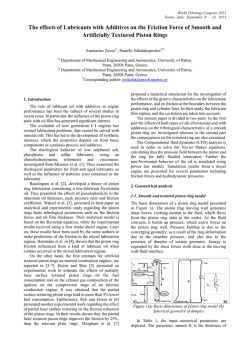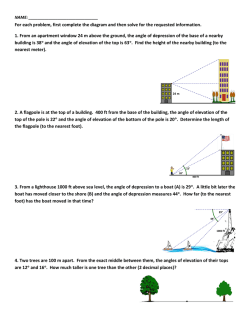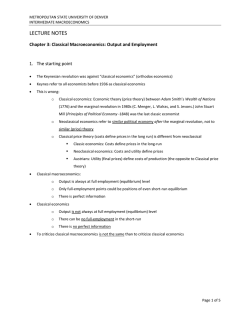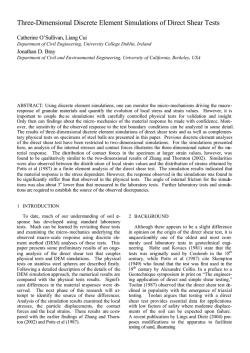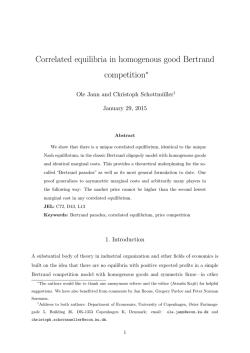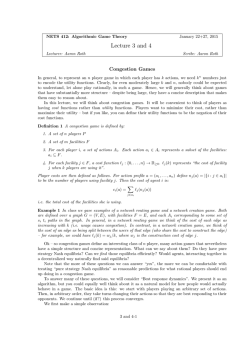
Lecture 12
Friction ME101 - Division III Kaustubh Dasgupta 1 Friction Usual Assumption till now: Forces of action and reaction between contacting surfaces act normal to the surface valid for interaction between smooth surfaces often involves only a relatively small error in solution in many cases ability of contacting surfaces to support tangential forces is very important (Ex: Figure above) Frictional Forces Tangential forces generated between contacting surfaces • occur in the interaction between all real surfaces • always act in a direction opposite to the direction of motion ME101 - Division III Kaustubh Dasgupta 2 Friction Frictional forces are Not Desired in some cases: • Bearings, power screws, gears, flow of fluids in pipes, propulsion of aircraft and missiles through the atmosphere, etc – Friction often results in a loss of energy, which is dissipated in the form of heat – Friction causes Wear Frictional forces are Desired in some cases: • Brakes, clutches, belt drives, wedges • walking depends on friction between the shoe and the ground Ideal Machine/Process: Friction small enough to be neglected Real Machine/Process: Friction must be taken into account ME101 - Division III Kaustubh Dasgupta 3 Types of Friction Dry Friction (Coulomb Friction) occurs between unlubricated surfaces of two solids Effects of dry friction acting on exterior surfaces of rigid bodies ME101 Fluid Friction occurs when adjacent layers in a fluid (liquid or gas) move at a different velocities. Fluid friction also depends on viscosity of the fluid. Fluid Mechanics Internal Friction occurs in all solid materials subjected to cyclic loading, especially in those materials, which have low limits of elasticity Material Science ME101 - Division III Kaustubh Dasgupta 4 Mechanism of Dry Friction • Block of weight W placed on horizontal surface. Forces acting on block are its weight and reaction of surface N. Φ • Small horizontal force P applied to block. For block to remain stationary, in equilibrium, a R horizontal component F of the surface reaction is required. F is a Static-Friction force. • As P increases, static-friction force F increases as well until it reaches a maximum value Fm. Fm s N • Further increase in P causes the block to begin to move as F drops to a smaller Kinetic-Friction force Fk. Fk k N Static Equilibrium ME101 - Division III Motion μs is the Coefficient of Static Friction μk is the Coefficient of Kinetic Friction Kaustubh Dasgupta 5 Mechanism of Dry Friction • Maximum static-friction force: Fm s N • Kinetic-friction force: Fk k N k 0.75 s • Maximum static-friction force and kineticfriction force are: - proportional to normal force - dependent on type and condition of contact surfaces A friction coefficient reflects roughness, which is a geometric property of surfaces - independent of contact area Surfaces in relative motion :: the contacts are more nearly along the tops of the humps :: t-components of the R’s are smaller than the “at rest” condition Force necessary to maintain motion is generally less than that required to start the block when the surface irregularities are more nearly in mesh Fm > Fk ME101 - Division III Kaustubh Dasgupta 6 Mechanism of Dry Friction • Four possible situations for a rigid body in contact with a horizontal surface: • Motion impending, (Px = Fm) • No friction, (Px = 0) • No motion, (Px < Fm) Equations of Equilibrium Valid Equations of Equilibrium Valid ME101 - Division III Equations of Equilibrium Valid Kaustubh Dasgupta • Motion, (Px > Fm) Equations of Equilibrium Not Valid 7 Mechanism of Dry Friction Sometimes convenient to replace normal force N & friction force F by their resultant R: • No friction • No motion • Motion impending F N tan s m s N N tan s s vertex angle ME101 - Division III Friction Angles s = angle of static friction, Kaustubh Dasgupta • Motion F N tan k k k N N tan k k k = angle of kinetic friction 8 Mechanism of Dry Friction • Consider block of weight W resting on board with variable inclination angle q. • No friction ME101 - Division III • No motion • Motion impending • Motion Angle of Repose = Angle of Static Friction The reaction R is not vertical anymore, and the forces acting on the block are not balanced Kaustubh Dasgupta 9 Dry Friction Example Determine the maximum angle Ө before the block begins to slip. μs = Coefficient of static friction between the block and the inclined surface Solution: Draw the FBD of the block Max angle occurs when F = Fmax = μs N Therefore, for impending motion: The maximum value of Ө is known as Angle of Repose ME101 - Division III Kaustubh Dasgupta 10 Dry Friction SOLUTION: • Determine values of friction force and normal reaction force from plane required to maintain equilibrium. Example • Calculate maximum friction force and compare with friction force required for equilibrium. If it is greater, block will not slide. A 100 N force acts as shown on a 300 N block placed on an inclined plane. The coefficients of friction between the block and plane are s = 0.25 and k = 0.20. Determine whether the block is in equilibrium and find the value of the friction force. ME101 - Division III • If maximum friction force is less than friction force required for equilibrium, block will slide. Calculate kineticfriction force. Kaustubh Dasgupta 11 Dry Friction SOLUTION: • Determine values of friction force and normal reaction force from plane required to maintain equilibrium. Fx 0 : 100 N - 53 300 N F 0 F 80 N Fy 0 : F acting upwards N - 54 300 N 0 N 240 N • Calculate maximum friction force and compare with friction force required for equilibrium. If it is greater, block will not slide. Fm s N Fm 0.25240 N 60 N The block will slide down the plane along F. ME101 - Division III Kaustubh Dasgupta 12 Dry Friction • If maximum friction force is less than friction force required for equilibrium, block will slide. Calculate kinetic-friction force. Factual Fk k N 0.20240 N Factual 48 N ME101 - Division III Kaustubh Dasgupta 13 Dry Friction Solution: (a) FBD for the block on the verge of tipping: Example The block moves with constant velocity under the action of P. μk is the Coefficient of Kinetic Friction. Determine: (a) Maximum value of h such that the block slides without tipping over (b) Location of a point C on the bottom face of the block through which resultant of the friction and normal forces must pass if h=H/2 ME101 - Division III The resultant of Fk and N passes through point B through which P must also pass, since three coplanar forces in equilibrium are concurrent. Friction Force: Fk = μk N since slipping occurs Ө = tan-1μk Kaustubh Dasgupta 14 Dry Friction Solution (a) Apply Equilibrium Conditions (constant velocity!) Alternatively, we can directly write from the geometry of the FBD: If h were greater than this value, moment equilibrium at A would not be satisfied and the block would tip over. Solution (b) Draw FBD Ө = tan-1μk since the block is slipping. From geometry of FBD: Alternatively use equilibrium equations ME101 - Division III Kaustubh Dasgupta 15
© Copyright 2026
